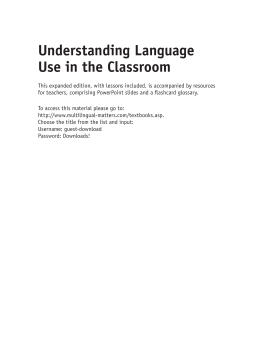
Additional Information
Book Details
Abstract
It is clear that a proper understanding of what academic English is and how to use it is crucial for success in college, and yet students face multiple obstacles in acquiring this new 'code', not least that their professors often cannot agree among themselves on a definition and a set of rules. Understanding Language Use in the Classroom aims to bring the latest findings in linguistics research on academic English to educators from a range of disciplines, and to help them help their students learn and achieve. In this expanded edition of the original text, college educators will find PowerPoint presentations and instructor materials to enhance the topics covered in the text. Using these additional resources in the classroom will help educators to engage their students with this crucial, but frequently neglected, area of their college education; and to inform students about the unexamined linguistic assumptions we all hold, and that hold us back. You can find additional materials on the Resources tab of our website.
Meticulously researched and methodically organized, this book is written in a clear, accessible style. Informed by extensive interviews and her own years of classroom experience, Behrens’ engaging examples demystify the academic English that we want our students to master. I value this book as a resource for understanding the needs of my students, particularly those in their first year.
Susan J. Behrens is Professor of Communication Sciences and Disorders, and Director of the Center for Teaching Innovation and Excellence, Marymount Manhattan College, New York, USA. She contributes weekly lessons on writing and English composition to The New York Times in Education (nytimesineducation.com). Her other publications include Grammar: A Pocket Guide (Routledge 2010) and Language in the Real World: An Introduction to Linguistics (with Judith A. Parker, Routledge 2010).
This important and highly accessible book demonstrates how an understanding of basic linguistics can help students improve their academic English. The comprehensive resources mean that the reader does not require a background in linguistics, and the clear and entertaining accompanying teaching materials will greatly assist educators with their lesson plans.
I am pleased to recommend this essential book on academic English from a renowned linguist. The accessible style, lesson plans, PowerPoints, and current topics make it a more useful text for students and instructors. Information on voice and speech science enhances the material on form and function of language.
Table of Contents
| Section Title | Page | Action | Price |
|---|---|---|---|
| DOI https://doi.org/10.21832/BEHREN9795 | iv | ||
| Contents | v | ||
| Author Biography | ix | ||
| Acknowledgments | xi | ||
| Introduction | xiii | ||
| Introduction to this Expanded Edition: Linguistic Stereotypes and Nine Lessons to Explore Assumptions about Language | xxi | ||
| Part 1 The Role of Academic Englishin Higher Education | 1 | ||
| 1 Linguistic Obstacles to Better Teaching and Learning | 3 | ||
| 2 Examining Academic English: Form and Function | 17 | ||
| 3 Linguistics and Pedagogy | 37 | ||
| Part 2 The Linguistic Conversations | 51 | ||
| 4 Introducing the Conversations: Linguistic Principles | 53 | ||
| 5 Word Formation/Morphology | 57 | ||
| 6 Word Meaning/Semantics | 65 | ||
| Instructor Guidance Material Lesson 1: ‘The First Lesson, Literally’: Words Change Meaning | 73 | ||
| Instructor Guidance Material Lesson 2: ‘Slang Should Know its Place’ | 77 | ||
| 7 Grammatical Markers/Morphosyntax | 82 | ||
| 8 Grammar and Punctuation/Syntax | 90 | ||
| Instructor Guidance Material Lesson 3: ‘Texting and Literacy Don’t Mix’ | 100 | ||
| 9 Narrative Structure/Discourse | 107 | ||
| Instructor Guidance Material Lesson 4: ‘Such Rude Talkers!’: Conversational Style Clashes | 113 | ||
| Instructor Guidance Material Lesson 5: ‘Do You Speak “Woman”?’ | 121 | ||
| 10 Pronunciation/ Phonology | 127 | ||
| Instructor Guidance Material Lesson 6: Light or Right? Three or tree? Sheep or Ship? Native language-influenced English | 136 | ||
| Instructor Guidance Material Lesson 7: ‘New Yawk Tawk’: The New York City ‘R’ | 142 | ||
| 11 Voice Quality and Speech Melody/Prosody | 149 | ||
| Instructor Guidance Material Lesson 8: ‘That Vocal Fry Says It All’: The Voices of Young Women | 155 | ||
| Instructor Guidance Material Lesson 9: ‘Do They Sound Gay?’ | 161 | ||
| Part 3 Study Sheets: Review Materials for More Conversations | 167 | ||
| Study Sheet A: Backformations | 168 | ||
| Study Sheet B: Common Derivational Morphemes | 169 | ||
| Study Sheet C: Common Word Conversions | 170 | ||
| Study Sheet D: Jargon/Words with Special Meanings | 171 | ||
| Study Sheet E: Idiomatic Use of Prepositions | 172 | ||
| Study Sheet F: Pronouns and the Case System | 174 | ||
| Study Sheet G: Ambiguous, Vague and Inconsistent Pronouns | 176 | ||
| Study Sheet H: Punctuation/Apostrophes and Commas | 177 | ||
| Study Sheet I: Subject-Verb Agreement Issues | 179 | ||
| Study Sheet J: Modifier Problems | 180 | ||
| Study Sheet K: Tense vs. Voice | 182 | ||
| Study Sheet L: Texting Features | 184 | ||
| Study Sheet M: Formality Continuum/Style | 185 | ||
| Study Sheet N: Transitional Expressions | 187 | ||
| Study Sheet O: Phonological Patterns and Processes | 188 | ||
| Study Sheet P: Acoustic Characteristics of Speech/Word Stress | 189 | ||
| Appendix | 191 | ||
| Glossary | 197 | ||
| References | 207 | ||
| Index | 221 |
